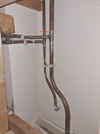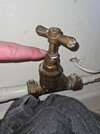- Joined
- 9 Mar 2025
- Messages
- 14
- Reaction score
- 1
- Country

If this combination cylinder is no longer used then it should be drained and decommissioned. It will be @ risk of the water being contaminated and a legionella risk.
At this point it might be best to decommission it. What's the best way of shutting off water all together to it as the valve going into it is leaking?


